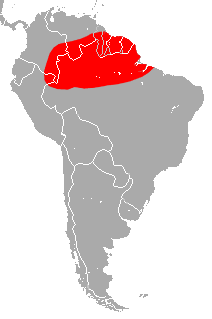
The big-eared woolly bat or (Peters's) woolly false vampire bat is a species of bat, belonging to the family Phyllostomidae.

The lesser ghost bat is a bat species found in South America. It is one of six bat species worldwide to have white fur.

The big red bat is a species of vesper bat from South and Central America.

Andersen's fruit-eating bat is a bat species found in South America.

Schmidts's big-eared bat is a bat species from South and Central America.

The Asian parti-colored bat is a species of parti-coloured bat. An adult Asian parti-colored bat has a body length of 6–7 cm (2.4–2.8 in), a tail of 4.3–4.5 cm (1.7–1.8 in), and a wing length of 5 cm (2.0 in). Asian parti-colored bats are distributed across East Asia, from Taiwan through eastern China, eastern Mongolia and Russia (Siberia) to the Korean Peninsula and Japan.
The Sumatran mastiff bat is a species of bat in the family Molossidae, the free-tailed bats. It is only known from Sumatra in Indonesia. It was described in 1907 and has not been recorded since.
Botta's serotine is a species of vesper bat, one of 25 in the genus Eptesicus. It is found in rocky areas and temperate desert.

The big-eared brown bat is a species of vesper bat found in Argentina, Paraguay, and Chile.

Rüppell's or the greater broad-nosed bat is a species of vespertilionid microbat found in eastern Australia.

Davies's big-eared bat or the graybeard bat is a species of bat in the family Phyllostomidae. It is named after James (Jim) Noel Davies who discovered it whilst on an expedition in British Guiana, South America in 1963. This was the Cambridge University expedition to the rainforest reserve near Bartica in British Guiana. This species can weigh 30 grams and has a wingspan of up to 50cm. It is bigger than most micronycteris bats with a fierce disposition. A small frog was found in the stomach of a specimen, and the bat is strong-willed enough to chew its way out of a cloth bag.

The greater musky fruit bat is a species of megabat in the family Pteropodidae. It is endemic to the Philippines. It was named by Peters for Fedor Jagor.

The black-bearded flying fox is an endangered species of megabat in the genus Pteropus. It is endemic to Indonesia, found on the islands of Ambon, Buru, Seram, Banda, and Yamdena. Currently considered monotypic, it formerly included the Aru flying fox and Kei flying fox as subspecies.

The great flying fox, also known as the greater flying fox or Bismarck flying fox, is a species of megabat in the genus Pteropus, found throughout lowland areas of New Guinea and in the Bismarck Archipelago. Conflicting evidence suggests that its closest relative is either the spectacled flying fox or, jointly, the Pelew and insular flying foxes. Two subspecies are recognized. At up to 1.6 kg (3.5 lb) in weight, it is among the heaviest bats in the world and the largest bat in Melanesia. It is a gregarious animal which roosts with hundreds or thousands of individuals. In part due to its wide variation in color, it has many taxonomic synonyms, including Pteropus degener, Pteropus papuanus, and Pteropus sepikensis. It may forage during the day or night in search of fruit, including figs or fruits from the family Sapotaceae. It is considered a least-concern species by the IUCN, though its numbers have been negatively impacted by what appeared to be a disease, as well as by hunting for bushmeat that occurs across its range.

Blasius's horseshoe bat is a species of insectivorous bat in the family Rhinolophidae found throughout large parts of the Mediterranean, Middle East and Africa.

The Bornean horseshoe bat is a species of bat in the family Rhinolophidae. It is found in Brunei, Cambodia, Indonesia, Laos, Malaysia, and Vietnam.

Decken's horseshoe bat is a species of horseshoe bat. It is found in Kenya and Tanzania. Its natural habitats are tropica and subtropical moist lowland and montane forest, moist savanna, caves and other subterranean habitats.

Phyllostominae is a subfamily of bats that include big-eared, spear-nosed, sword-nosed bats and relatives.

The Aru flying fox is a Critically Endangered species of megabat found in the Aru Islands in Indonesia. It was described by Wilhelm Peters in 1867. It was formerly considered a subspecies of the black-bearded flying fox. The species is poorly known, and has not been encountered since the 19th century. It is classified as critically endangered by the IUCN and is listed on CITES appendix II.

The big-eared flying fox is a species of bat in the family Pteropodidae, larger bats who subsist largely on fruits. The species is distributed across a range in Indonesia, Papua New Guinea and islands nearing the Cape York peninsula at the northeast of Australia, at elevations less than 500 metres and often in coastal mangroves.



















